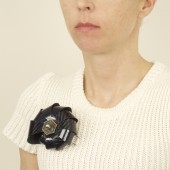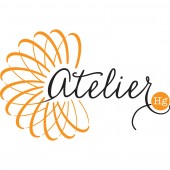Nautilus Carboniferous Brooch / Spilla by Ezra Satok-Wolman |
Home > Winners > #31996 |
 |
|
||||
| DESIGN DETAILS | |||||
| DESIGN NAME: Nautilus Carboniferous PRIMARY FUNCTION: Brooch / Spilla INSPIRATION: The brooch is inspired by the relationship between nature and mathematics and deals specifically with the golden ratio. The pierced "flower of life" plate along with the nautilus form represent examples of the mathematical beauty that can be found throughout the natural world. The nautilus shell, which is generated using a logarithmic spiral, and the hexagon are two of the more prevalent geometries observed in nature and are merged in this particular design to achieve a visual and symbolic harmony. UNIQUE PROPERTIES / PROJECT DESCRIPTION: A unique hand made brooch fabricated using a carbon fibre/kevlar composite, in conjunction with gold, palladium and a Tahitian pearl. The brooch is incredibly light weight and voluminous due to the unique properties of the carbon fibre composite. OPERATION / FLOW / INTERACTION: The brooch is designed to be worn on a jacket or sweater and can be customized in several ways. PROJECT DURATION AND LOCATION: The project started in November 2013 in Caledon, Ontario and finished in January 2014 in Caledon, Ontario. |
PRODUCTION / REALIZATION TECHNOLOGY: A template for the shell components was applied to the surface of the carbon/kevlar. Using extremely sharp shears the pieces were cut and sanded. Each carbon/kevlar section was drilled in precise locations for the structural element that secures the pieces together. The "Flower of Life" plate was pierced using Italian traforo techniques and soldered into a hexagonal yellow gold frame. The components were then carefully assembled, including a Tahitian pearl and a hand made clasp in 18k white gold. SPECIFICATIONS / TECHNICAL PROPERTIES: The brooch dimensions are- Width 95.50 mm x Depth 45.50 mm x Height 81.80 mm. The total weight of the brooch is only 22g. This is extremely light weight for a brooch of this size and volume. TAGS: Carbon fibre, Kevlar, Nautilus, Flower of life, Ezra Satok-Wolman, Atelier Hg RESEARCH ABSTRACT: A variation of the design was originally produced in 2010 using 18k gold alloys to create the nautilus form. The first carbon fibre nautilus brooch was produced in 2013, using a 100% carbon fibre twill sheet, greatly reducing production costs and the weight of the brooch. After successfully producing that piece, research began to explore carbon fibre/ Kevlar composites, which added colour to the twill. CHALLENGE: The material is difficult to cut due to its extreme strength, and very precise pieces were required to create the body of the nautilus form. Due to the fact that this is a non-metallic material, the brooch needed to be assembled mechanically. The material was chosen for its unusual and aesthetically pleasing visual qualities and for its structural integrity and light weight. ADDED DATE: 2014-01-21 13:41:51 TEAM MEMBERS (1) : IMAGE CREDITS: Image #1: Photographer Ezra Satok-Wolman, Nautilus Carboniferous, 2014. Image #2: Photographer Ezra Satok-Wolman, Nautilus Carboniferous, 2014. Image #3: Photographer Ezra Satok-Wolman, Nautilus Carboniferous, 2014. Image #4: Photographer Ezra Satok-Wolman, Nautilus Carboniferous, 2014. Image #5: Photographer Ezra Satok-Wolman, Nautilus Carboniferous, 2014. |
||||
| Visit the following page to learn more: http://www.atelierhg.com | |||||
| AWARD DETAILS | |
 |
Nautilus Carboniferous Brooch/Spilla by Ezra Satok-wolman is Winner in Jewelry Design Category, 2013 - 2014.· Read the interview with designer Ezra Satok-Wolman for design Nautilus Carboniferous here.· Press Members: Login or Register to request an exclusive interview with Ezra Satok-Wolman. · Click here to register inorder to view the profile and other works by Ezra Satok-Wolman. |
| SOCIAL |
| + Add to Likes / Favorites | Send to My Email | Comment | Testimonials | View Press-Release | Press Kit | Translations |
Did you like Ezra Satok-Wolman's Jewelry Design?
You will most likely enjoy other award winning jewelry design as well.
Click here to view more Award Winning Jewelry Design.








